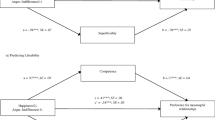Abstract
Objectives
To explain blushing phobics’ fearful preoccupation with blushing, this study investigated the anticipated consequences of displaying a blush on others’ judgements of the self and of the incident. We tested whether especially in the context of ambiguous situations that may be interpreted as a transgression, individuals would expect negative consequences of their blushing, and whether this effect is most pronounced in relatively high blushing fearful individuals.
Design and method
Using a vignette approach, participants (N = 36) with variable levels of blushing fear were instructed to imagine that they did or did not started blushing (i) after a mishap and (ii) in situations that are more ambiguous in their meaning.
Results
Independent of situation, participants indicated to expect a positive rather than a negative influence of blushing on others’ judgements of the self and of the incident. Unexpectedly, this pattern was even most pronounced in relatively fearful individuals.
Conclusion
The results are in conflict with the idea that fear of blushing is fuelled by overestimating the undesirable communicative effects of blushing in ambiguous situations. In addition, the results seem to imply that different processes are involved in judging blushing others and judging other’s views of themselves when displaying a blush.
Similar content being viewed by others
Notes
The vignettes that were used in this study can be obtained upon request from the first author.
References
Bögels, S. M., Alberts, M., & de Jong, P. J. (1996). Self-consciousness, self-focused attention, blushing propensity, and fear of blushing. Personality and Individual Differences, 21, 573–581.
Bögels S. M., & Reith, W. (1999).Validity of two questionnaires to assess social fears: The Dutch Social Phobia and Anxiety Inventory and the Fear of Blushing, Trembling, and Sweating Questionnaire. Psychopathology and Behavioral Assessment, 21, 51–66.
Castelfranchi, C., & Poggi I. (1990). Blushing as a discourse: Was Darwin wrong? In W. R. Crozier (Ed.), Shyness and embarrassment: Perspectives from social psychology. Cambridge: Cambridge University Press, pp. 230–251.
Crozier, W. R. (2001). Blushing and the exposed self: Darwin revisited. Journal for the Theory of Social Behavior, 31, 61–72.
Crozier, W. R. (2004). Self-consciousness, exposure, and the blush. Journal for the Theory of Social Behavior, 34, 1–17.
de Jong, P. J. (1999). Communicative and remedial effects of social blushing. Journal of Nonverbal Behavior, 23, 197–218.
de Jong, P. J., & Peters, M. L. (2005). Do blushing phobics overestimate the undesirable communicative effects of their blushing? Behaviour Research and Therapy, 43, 747–758.
de Jong, P. J., Peters, M., & De Cremer, D. (2003). Blushing may signify guilt: Revealing effects of blushing in ambiguous social situations. Motivation and Emotion, 27, 225–249.
de Jong, P. J., Peters, M., De Cremer, D., & Vranken, C. (2002). Blushing after a moral transgression in a prisoner’s dilemma game: Appeasing or revealing? European Journal of Social Psychology, 32, 627–644.
Drummond, P., & Lim, H. K. (2000). Significance of blushing for fair- and dark-skinned people. Personality and Individual Differences, 29, 1123–1132.
Jones, E. E., & Davis, K. E. (1965). From acts to dispositions: The attribution process in person perception. In L. Berkowitz (Ed.), Advances in experimental social psychology (vol 2). New York: Academic Press.
Keltner, D. (1995). Signs of appeasement: Evidence for the distinct displays of embarrassment, amusement, and shame. Journal of Personality and Social Psychology, 68, 441–454.
Keltner, D., Young, R. C., & Buswell, B. N. (1997). Appeasement in human emotion, social practice, and personality. Aggressive Behavior, 23, 359–374.
Leary, M. (1983). A brief version of the Fear of Negative Evaluation Scale. Personality and Social Psychology Bulletin, 9, 371–375.
Leary, M. R., Landel J. L., & Patton, K. M. (1996). The motivated expression of embarrassment following a self-presentational predicament. Journal of Personality, 64, 619–636.
Marks, I., & Mathews, A. M. (1979). Brief standard self-rating for phobic patients. Behaviour Research and Therapy, 17, 263–267.
Mulkens, S., de Jong, P. J., Dobbelaar, A., & Bögels, S. M. (1999). Fear of blushing: Fearful preoccupation irrespective of facial coloration. Behaviour Research and Therapy, 37, 1119–1128.
Mulkens S., Bögels S. M., de Jong P. J., & Louwers, J. (2001). Fear of blushing: Effects of task concentration training versus exposure in vivo on fear and physiology. Journal of Anxiety Disorders, 15, 413–432.
Neto, F. (1996). Correlates of social blushing. Personality & Individual Differences, 20, 365–373.
Parkinson, B., & Manstead, A. S. R. (1993). Making sense of emotion in stories and social life. Cognition and Emotion, 7, 295–323.
Semin, G. R., & Manstead, A. S. R. (1982). The social implications of embarrassment displays and restitution behavior. European Journal of Social Psychology, 12, 367–377.
Smits, A. (2003). True innocence doesn’t need a blush, or does it? A study on the context dependency of the communicative and remedial effects of blushing in the context of a prisoner’s deilemma game. Master’s thesis, University of Maastricht.
Vorauer , J. D. (2001). The other side of the story: Transparency estimation in social interaction. In G. B. Moskowitz (Ed.), Cognitive Social Psychology. London: Lawrence Erlbaum.
Vorauer, J. D., & Miller, D. T. (1997). Failure to recognize the effect of implicit social influence on the presentation of self. Journal of Personality and Social Psychology, 73, 281–295.
Acknowledgments
The authors are very grateful to Marieke Timmermans for her statistical advice and her assistance in analysing the data. The third author was supported by a fellowship of the Netherlands Organisation for Scientific Research (NWO, Grant No. 400-03-042).
Author information
Authors and Affiliations
Corresponding author
Rights and permissions
About this article
Cite this article
de Jong, P.J., Peters, M.L., Dijk, C. et al. Fear of Blushing: The Role of the Expected Influence of Displaying a Blush on Others’ Judgements. Cogn Ther Res 30, 623–634 (2006). https://doi.org/10.1007/s10608-006-9040-y
Published:
Issue Date:
DOI: https://doi.org/10.1007/s10608-006-9040-y




